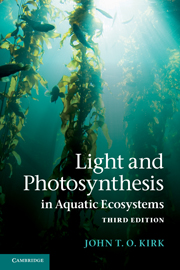Book contents
- Frontmatter
- Contents
- Preface to the third edition
- Part I The underwater light field
- 1 Concepts of hydrologic optics
- 2 Incident solar radiation
- 3 Absorption of light within the aquatic medium
- 4 Scattering of light within the aquatic medium
- 5 Characterizing the underwater light field
- 6 The nature of the underwater light field
- 7 Remote sensing of the aquatic environment
- Part II Photosynthesis in the aquatic environment
- References and author index
- Index to symbols
- Index to organisms
- Index to water bodies
- Subject index
- Plate Section
4 - Scattering of light within the aquatic medium
Published online by Cambridge University Press: 05 January 2013
- Frontmatter
- Contents
- Preface to the third edition
- Part I The underwater light field
- 1 Concepts of hydrologic optics
- 2 Incident solar radiation
- 3 Absorption of light within the aquatic medium
- 4 Scattering of light within the aquatic medium
- 5 Characterizing the underwater light field
- 6 The nature of the underwater light field
- 7 Remote sensing of the aquatic environment
- Part II Photosynthesis in the aquatic environment
- References and author index
- Index to symbols
- Index to organisms
- Index to water bodies
- Subject index
- Plate Section
Summary
We have seen that most of the solar photons which enter the water are absorbed. Many of these photons – most, in some waters – undergo scattering one or more times before they are absorbed. Scattering does not by itself remove light – a scattered photon is still available for photosynthesis. The effect of scattering is to impede the vertical penetration of light. It makes the photons follow a zig-zag path as they ricochet from one scattering particle to the next. This increases the total pathlength that the photons must follow in traversing a certain depth, and so increases the probability of their being captured by one of the absorbing components of the medium. In addition, some of the photons are actually scattered back in an upwards direction. Thus the effect of scattering is to intensify the vertical attenuation of the light.
In this chapter we shall consider the nature of the scattering process and the scattering properties of natural waters.
The scattering process
What do we mean by scattering? We say that a photon is scattered when it interacts with some component of the medium in such a way that it is caused to diverge from its original path. There are two kinds of scattering to be considered – density fluctuation scattering and particle scattering.
Density fluctuation scattering
In understanding the basis of density fluctuation scattering in liquids, it is helpful to begin with a consideration of molecular, or Rayleigh, scattering by gases such as air. According to the Rayleigh theory, within any particle, such as an air molecule, in a light field, a dipole is induced by the electrical vector of the field. As the dipole oscillates at the frequency of the exciting radiation, it emits radiation of the same frequency in all directions. It is this radiation that is the scattered light.
- Type
- Chapter
- Information
- Light and Photosynthesis in Aquatic Ecosystems , pp. 98 - 132Publisher: Cambridge University PressPrint publication year: 2010



